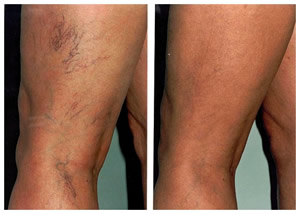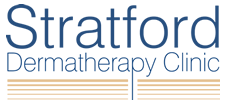What is microsclerotherapy and how does it work?
Microsclerotherapy is a technique of injecting thread or spider veins with a special substance known as a “sclerosant” that causes swelling in the vein’s wall.
If the vein is small enough, the swelling will destroy the vein over several weeks, making it much less noticeable or even invisible.
Microsclerotherapy is normally used for the treatment of leg thread veins and is rarely used for the treatment of facial veins owing to the small possibility of scarring that can occur.
Costs for leg veins injections start at £300.
ALL thread vein removal procedures are done by doctors in a safe medical setting.

See more before and afters in our gallery
We do not offer laser therapy for leg veins but can refer on to appropriate medical clinics if necessary.
- Treatment by doctors only
- No downtime
- No anaesthesia required
- Painless
Dear Dr Hugo
“I had seen the advert for Stratford Dermatherapy Clinic many times in our local press so decided to peruse their website. What initially drew me in were the ‘before and after’ photos of nose reconstruction using dermal fillers. Approaching 60, the chance to finally have something resembling the nose I had always wanted made me overcome my reticence at walking into, what I had imagined, would be an intimidating place. I needn’t have worried as Hugo and Karen are the most friendly and welcoming people. I left their clinic after that first visit walking on air.
Not only did I get my lovely ‘new’ nose, but some subtle enhancements to my lips and naso-labial lines. No trout pouts here! I just looked refreshed and less down at the mouth. Be warned, this is the sort of place that makes you want to go back for more. I have had top ups to the above treatments a couple of times now after approximately a year and 18 months. My nose has never reverted back to its original shape, but small top ups give me the confidence that it never will. Dr Hugo is also very honest and would advise strongly against any treatment he thinks you do not need.
Since then I have had annoying, small thread veins removed from my face and legs and my latest treatment, which I requested , was Pelleve. Two sessions have restored my jawline quite visibly and this is not even the final result as the results are progressive over approximately 6 months.
I am almost 63 and three people in recent times, independently of each other, have shown surprise at my age, believing I was around 52. I’ll happily settle for that. I will continue my annual pilgrimage to see Dr Hugo now until I drop, safe in the knowledge that I am in good hands. My only worry is that he will retire before I reach that point.”
Mrs D. H.
What happens during the treatment and how long will it take to recover?
The first time you visit a clinic, a detailed discussion with a practitioner should clearly highlight your expectations of the cosmetic effect from this treatment. The practitioner should then be able to tell you if this is how they see the treatment working for you. If your expectations and theirs do not match each other, do not proceed until you are entirely happy with what they are telling you.
The practitioner may then take a medical history to make sure that there are no reasons why you are not suited to be treated with microsclerotherapy. Then you would normally be asked to sign a consent form, which means that you have understood what the treatment may do, and the potential side effects.
Photographs may also be taken by the practitioner that can be used as a “before and after” comparison to show you how successful your treatment has been.
All this may happen in your first visit. If you are happy to proceed further, the practitioner may also go ahead with your first treatment at this time. Equally, you may decide to keep your treatment separate from the necessary “paperwork” and not begin the procedure until your next consultation.
The procedure
There is usually minimal or no discomfort during microsclerotherapy injections due to the size of the needle and the superficial injection technique.
The solutions used may differ in strength slightly depending on the size of the vessel to be injected. Your physician will decide which solution is best for your particular case.
Following injections, a swab may be taped over the treated area, and often a special bandage and compression stocking is applied which may be worn for several days to help assist shrinkage of the thread veins.
Repeat procedures
A single blood vessel may have to be injected more than once, depending on its size.
Repeat injection sessions can be scheduled one week later, but it is better to wait one month between treatments.
In practice, most patients require between 2 and 6 treatments at 4 to 8 week intervals.
It is common for around 75 percent or more of your veins to vanish, but you should be aware that 100 percent disappearance of all veins is rare.
Recovery time
The whole treatment should usually take no longer than half an hour or so – depending on how many veins require treatment.
You can normally drive immediately and go about your usual daily activities following this treatment.
Sclerotherapy and Microsclerotherapy Side Effects
Does it hurt and what could go wrong? Some pain or burning at the injection site may occur following injections, and some patients experience restlessness in their legs during the first few nights. This is due to the swelling of the walls of the veins.
For a month or so, the vessels may appear more prominent. The injection sites look like insect bites, and may occasionally itch. The veins gradually begin to fade and continue to improve for up to 8 weeks. After this time, a brownish discolouration of the skin may continue and may take many months to fade away.
Complications following microsclerotherapy are very rare, but the solution can sometimes escape from the veins and cause inflammation in the skin surrounding the treated area. There is also a small risk of the development of tiny ulcers, which may leave a small pink or white scar on healing.
Occasionally you may also find new veins developing in the treated areas, or even old veins flaring up again.
What should you do after treatment?
As we have said, your life can proceed as normal following a microsclerotherapy treatment session, but as with all medical procedures, it is wise to observe the advice of your practitioner as closely as possible to ensure that you get the full benefit of the treatment, and avoid complications.
Post-treatment advice may include:
- keeping the compression stocking dry and you may be asked to try and raise your legs as much as possible during the first 24 hours;
- removing the stocking and cotton wool pads after 24-48 hours. Short walks are fine, but try to avoid vigorous exercise for a few days;
- wearing your compression stockings if advised, for four weeks after the last treatment;
- avoiding Aspirin-based painkillers and replacing them with paracetamol for six weeks after the last treatment;
- contact your practitioner immediately if you notice any signs of infection or a sudden increase in pain.
What sort of practitioner can perform microsclerotherapy?
Manufacturers recommend that only medically qualified practitioners should use these treatments. Thus you will find many nurses, as well as general practitioners, dermatologists, and surgeons using this treatment.Manufacturers do not recommend that beauticians or any other person outside the medical profession use microsclerotherapy.
Summary
Microsclerotherapy is still a widely used treatment and is considered by many clinicians as the treatment of choice for leg thread veins.Newer alternatives such as lasers and IPL and microwave machinesare now available.Results with this type of equipment are improving and can be comparable to those achieved with microsclerotherapy. As a result of this, and due to the small potential for scarring with microsclerotherapy, these alternatives are certainly becoming more popular for the treatment of facial thread veins.
Laser and IPL machines are more suitable if you have large areas of your legs affected by thread veins, and microwave treatment may be a better option for very small thread veins that are difficult to inject.
In general, microsclerotherapy is now mainly used for the treatment of leg thread veins, and most patients require between 2 and 6 treatments at 4 to 8 week intervals.
The success rate is usually as high as 75% or more, but don’t expect to be rid of every single thread vein as 100% disappearance of all veins is rare.
